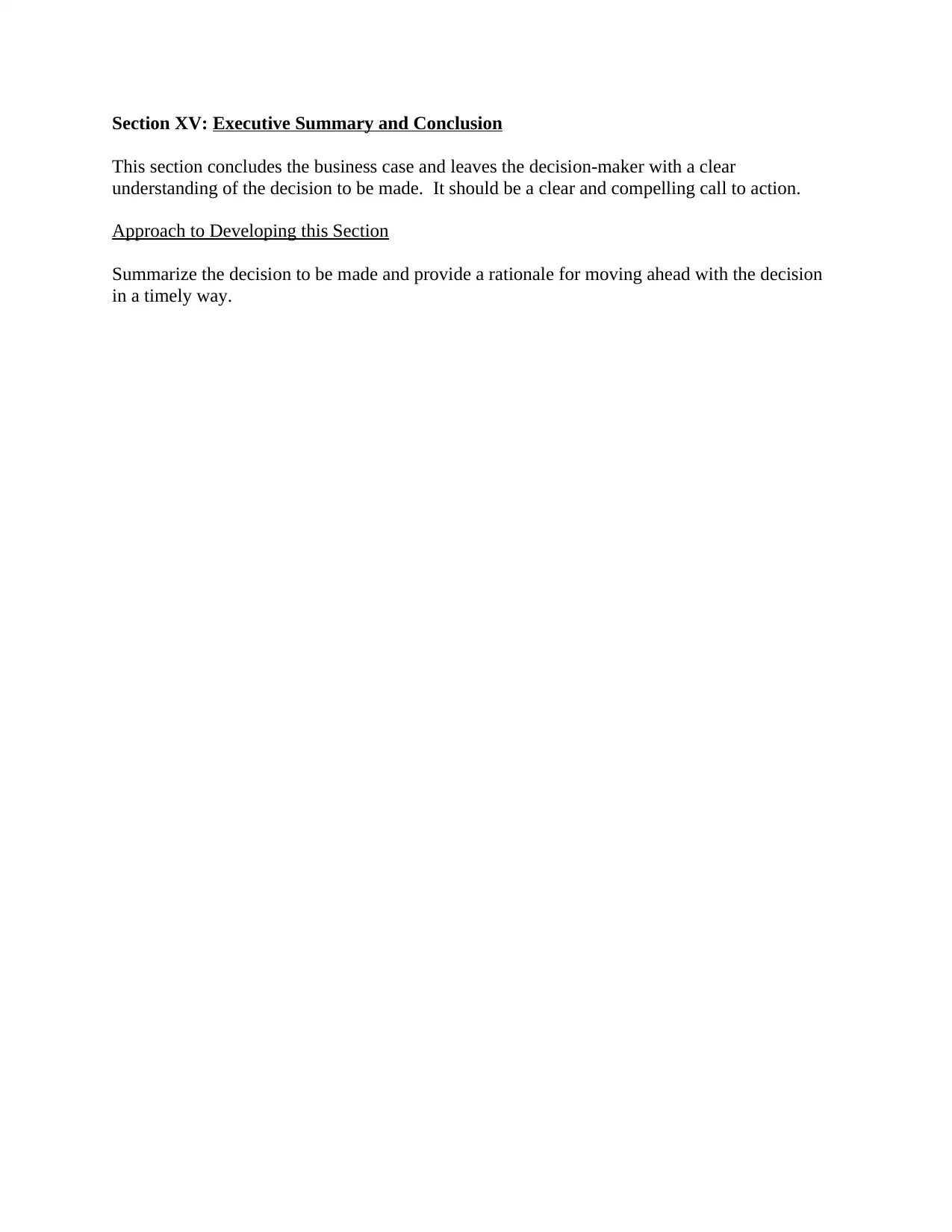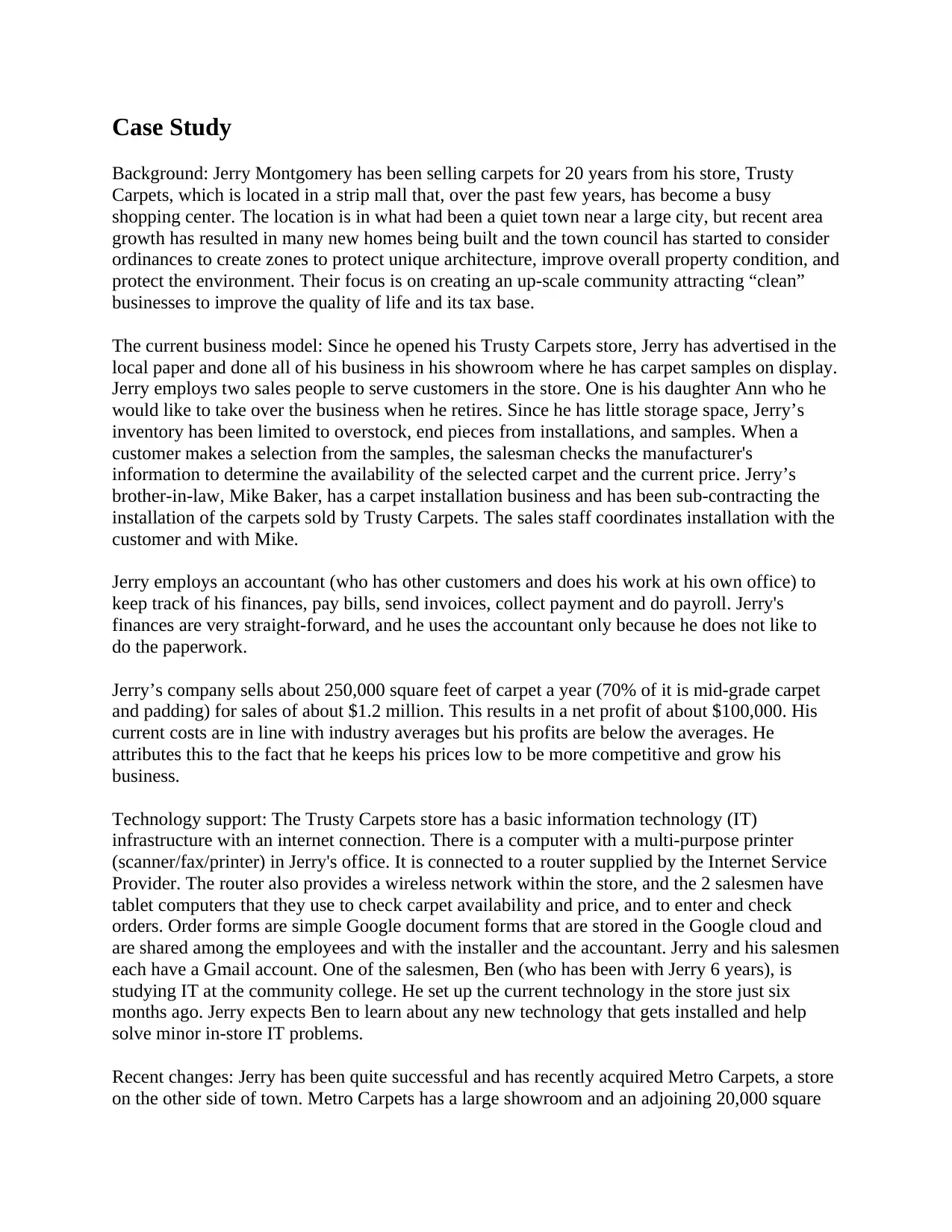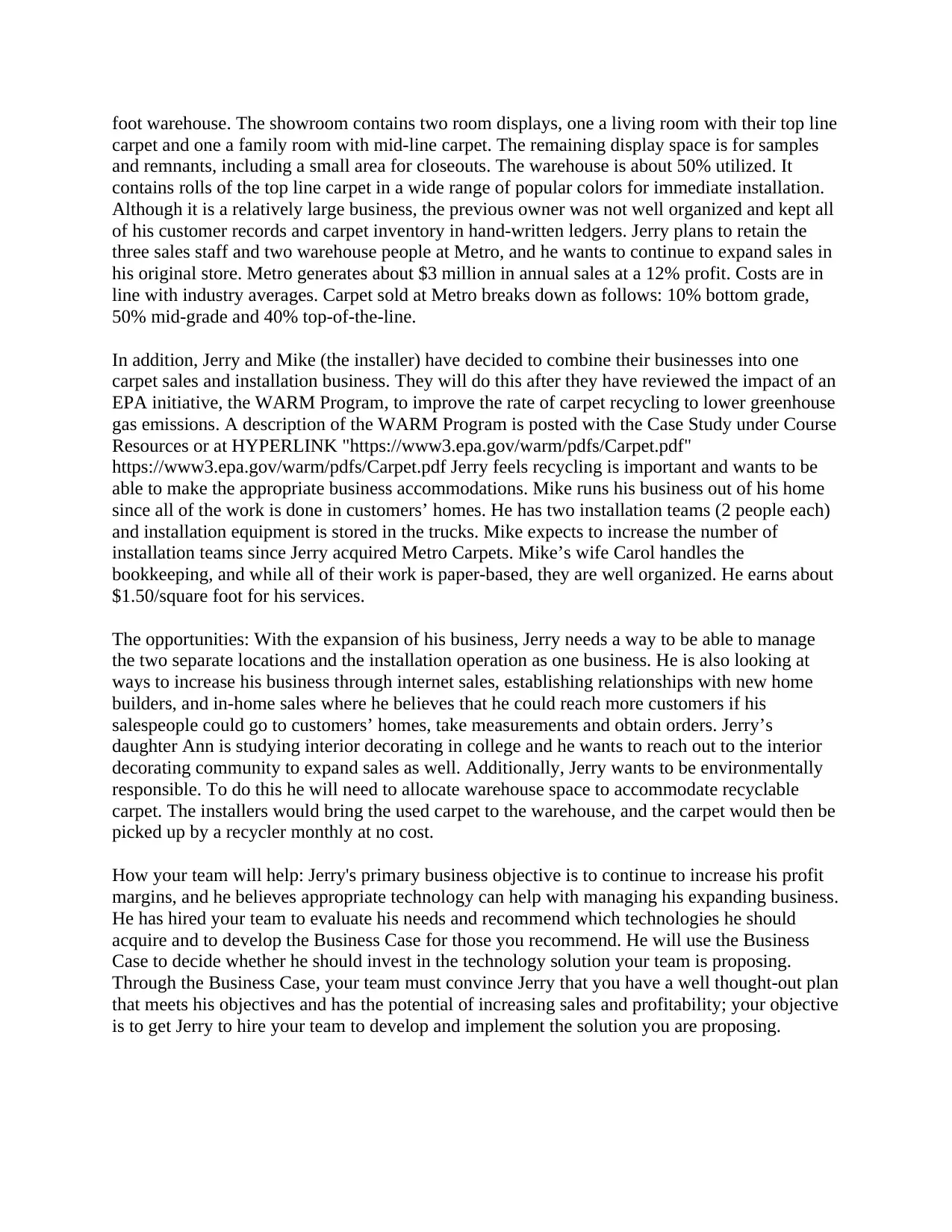Trusty Carpets Case Study
VerifiedAdded on 2019/09/23
|4
|1354
|164
Case Study
AI Summary
This case study presents the challenges faced by Jerry Montgomery, owner of Trusty Carpets, as his business expands. After acquiring Metro Carpets and merging with an installation business, Jerry needs a technology solution to manage his operations more efficiently. The case details his current business model, including sales, inventory, and accounting processes. It highlights opportunities for growth through internet sales, new home builder relationships, and in-home sales. The primary objective is to increase profit margins. The solution involves recommending appropriate technologies and developing a business case to convince Jerry to invest in the proposed solution. The case also considers the environmental impact of carpet recycling through the EPA's WARM program.

Section XV: Executive Summary and Conclusion
This section concludes the business case and leaves the decision-maker with a clear
understanding of the decision to be made. It should be a clear and compelling call to action.
Approach to Developing this Section
Summarize the decision to be made and provide a rationale for moving ahead with the decision
in a timely way.
This section concludes the business case and leaves the decision-maker with a clear
understanding of the decision to be made. It should be a clear and compelling call to action.
Approach to Developing this Section
Summarize the decision to be made and provide a rationale for moving ahead with the decision
in a timely way.
Paraphrase This Document
Need a fresh take? Get an instant paraphrase of this document with our AI Paraphraser

Case Study
Background: Jerry Montgomery has been selling carpets for 20 years from his store, Trusty
Carpets, which is located in a strip mall that, over the past few years, has become a busy
shopping center. The location is in what had been a quiet town near a large city, but recent area
growth has resulted in many new homes being built and the town council has started to consider
ordinances to create zones to protect unique architecture, improve overall property condition, and
protect the environment. Their focus is on creating an up-scale community attracting “clean”
businesses to improve the quality of life and its tax base.
The current business model: Since he opened his Trusty Carpets store, Jerry has advertised in the
local paper and done all of his business in his showroom where he has carpet samples on display.
Jerry employs two sales people to serve customers in the store. One is his daughter Ann who he
would like to take over the business when he retires. Since he has little storage space, Jerry’s
inventory has been limited to overstock, end pieces from installations, and samples. When a
customer makes a selection from the samples, the salesman checks the manufacturer's
information to determine the availability of the selected carpet and the current price. Jerry’s
brother-in-law, Mike Baker, has a carpet installation business and has been sub-contracting the
installation of the carpets sold by Trusty Carpets. The sales staff coordinates installation with the
customer and with Mike.
Jerry employs an accountant (who has other customers and does his work at his own office) to
keep track of his finances, pay bills, send invoices, collect payment and do payroll. Jerry's
finances are very straight-forward, and he uses the accountant only because he does not like to
do the paperwork.
Jerry’s company sells about 250,000 square feet of carpet a year (70% of it is mid-grade carpet
and padding) for sales of about $1.2 million. This results in a net profit of about $100,000. His
current costs are in line with industry averages but his profits are below the averages. He
attributes this to the fact that he keeps his prices low to be more competitive and grow his
business.
Technology support: The Trusty Carpets store has a basic information technology (IT)
infrastructure with an internet connection. There is a computer with a multi-purpose printer
(scanner/fax/printer) in Jerry's office. It is connected to a router supplied by the Internet Service
Provider. The router also provides a wireless network within the store, and the 2 salesmen have
tablet computers that they use to check carpet availability and price, and to enter and check
orders. Order forms are simple Google document forms that are stored in the Google cloud and
are shared among the employees and with the installer and the accountant. Jerry and his salesmen
each have a Gmail account. One of the salesmen, Ben (who has been with Jerry 6 years), is
studying IT at the community college. He set up the current technology in the store just six
months ago. Jerry expects Ben to learn about any new technology that gets installed and help
solve minor in-store IT problems.
Recent changes: Jerry has been quite successful and has recently acquired Metro Carpets, a store
on the other side of town. Metro Carpets has a large showroom and an adjoining 20,000 square
Background: Jerry Montgomery has been selling carpets for 20 years from his store, Trusty
Carpets, which is located in a strip mall that, over the past few years, has become a busy
shopping center. The location is in what had been a quiet town near a large city, but recent area
growth has resulted in many new homes being built and the town council has started to consider
ordinances to create zones to protect unique architecture, improve overall property condition, and
protect the environment. Their focus is on creating an up-scale community attracting “clean”
businesses to improve the quality of life and its tax base.
The current business model: Since he opened his Trusty Carpets store, Jerry has advertised in the
local paper and done all of his business in his showroom where he has carpet samples on display.
Jerry employs two sales people to serve customers in the store. One is his daughter Ann who he
would like to take over the business when he retires. Since he has little storage space, Jerry’s
inventory has been limited to overstock, end pieces from installations, and samples. When a
customer makes a selection from the samples, the salesman checks the manufacturer's
information to determine the availability of the selected carpet and the current price. Jerry’s
brother-in-law, Mike Baker, has a carpet installation business and has been sub-contracting the
installation of the carpets sold by Trusty Carpets. The sales staff coordinates installation with the
customer and with Mike.
Jerry employs an accountant (who has other customers and does his work at his own office) to
keep track of his finances, pay bills, send invoices, collect payment and do payroll. Jerry's
finances are very straight-forward, and he uses the accountant only because he does not like to
do the paperwork.
Jerry’s company sells about 250,000 square feet of carpet a year (70% of it is mid-grade carpet
and padding) for sales of about $1.2 million. This results in a net profit of about $100,000. His
current costs are in line with industry averages but his profits are below the averages. He
attributes this to the fact that he keeps his prices low to be more competitive and grow his
business.
Technology support: The Trusty Carpets store has a basic information technology (IT)
infrastructure with an internet connection. There is a computer with a multi-purpose printer
(scanner/fax/printer) in Jerry's office. It is connected to a router supplied by the Internet Service
Provider. The router also provides a wireless network within the store, and the 2 salesmen have
tablet computers that they use to check carpet availability and price, and to enter and check
orders. Order forms are simple Google document forms that are stored in the Google cloud and
are shared among the employees and with the installer and the accountant. Jerry and his salesmen
each have a Gmail account. One of the salesmen, Ben (who has been with Jerry 6 years), is
studying IT at the community college. He set up the current technology in the store just six
months ago. Jerry expects Ben to learn about any new technology that gets installed and help
solve minor in-store IT problems.
Recent changes: Jerry has been quite successful and has recently acquired Metro Carpets, a store
on the other side of town. Metro Carpets has a large showroom and an adjoining 20,000 square

foot warehouse. The showroom contains two room displays, one a living room with their top line
carpet and one a family room with mid-line carpet. The remaining display space is for samples
and remnants, including a small area for closeouts. The warehouse is about 50% utilized. It
contains rolls of the top line carpet in a wide range of popular colors for immediate installation.
Although it is a relatively large business, the previous owner was not well organized and kept all
of his customer records and carpet inventory in hand-written ledgers. Jerry plans to retain the
three sales staff and two warehouse people at Metro, and he wants to continue to expand sales in
his original store. Metro generates about $3 million in annual sales at a 12% profit. Costs are in
line with industry averages. Carpet sold at Metro breaks down as follows: 10% bottom grade,
50% mid-grade and 40% top-of-the-line.
In addition, Jerry and Mike (the installer) have decided to combine their businesses into one
carpet sales and installation business. They will do this after they have reviewed the impact of an
EPA initiative, the WARM Program, to improve the rate of carpet recycling to lower greenhouse
gas emissions. A description of the WARM Program is posted with the Case Study under Course
Resources or at HYPERLINK "https://www3.epa.gov/warm/pdfs/Carpet.pdf"
https://www3.epa.gov/warm/pdfs/Carpet.pdf Jerry feels recycling is important and wants to be
able to make the appropriate business accommodations. Mike runs his business out of his home
since all of the work is done in customers’ homes. He has two installation teams (2 people each)
and installation equipment is stored in the trucks. Mike expects to increase the number of
installation teams since Jerry acquired Metro Carpets. Mike’s wife Carol handles the
bookkeeping, and while all of their work is paper-based, they are well organized. He earns about
$1.50/square foot for his services.
The opportunities: With the expansion of his business, Jerry needs a way to be able to manage
the two separate locations and the installation operation as one business. He is also looking at
ways to increase his business through internet sales, establishing relationships with new home
builders, and in-home sales where he believes that he could reach more customers if his
salespeople could go to customers’ homes, take measurements and obtain orders. Jerry’s
daughter Ann is studying interior decorating in college and he wants to reach out to the interior
decorating community to expand sales as well. Additionally, Jerry wants to be environmentally
responsible. To do this he will need to allocate warehouse space to accommodate recyclable
carpet. The installers would bring the used carpet to the warehouse, and the carpet would then be
picked up by a recycler monthly at no cost.
How your team will help: Jerry's primary business objective is to continue to increase his profit
margins, and he believes appropriate technology can help with managing his expanding business.
He has hired your team to evaluate his needs and recommend which technologies he should
acquire and to develop the Business Case for those you recommend. He will use the Business
Case to decide whether he should invest in the technology solution your team is proposing.
Through the Business Case, your team must convince Jerry that you have a well thought-out plan
that meets his objectives and has the potential of increasing sales and profitability; your objective
is to get Jerry to hire your team to develop and implement the solution you are proposing.
carpet and one a family room with mid-line carpet. The remaining display space is for samples
and remnants, including a small area for closeouts. The warehouse is about 50% utilized. It
contains rolls of the top line carpet in a wide range of popular colors for immediate installation.
Although it is a relatively large business, the previous owner was not well organized and kept all
of his customer records and carpet inventory in hand-written ledgers. Jerry plans to retain the
three sales staff and two warehouse people at Metro, and he wants to continue to expand sales in
his original store. Metro generates about $3 million in annual sales at a 12% profit. Costs are in
line with industry averages. Carpet sold at Metro breaks down as follows: 10% bottom grade,
50% mid-grade and 40% top-of-the-line.
In addition, Jerry and Mike (the installer) have decided to combine their businesses into one
carpet sales and installation business. They will do this after they have reviewed the impact of an
EPA initiative, the WARM Program, to improve the rate of carpet recycling to lower greenhouse
gas emissions. A description of the WARM Program is posted with the Case Study under Course
Resources or at HYPERLINK "https://www3.epa.gov/warm/pdfs/Carpet.pdf"
https://www3.epa.gov/warm/pdfs/Carpet.pdf Jerry feels recycling is important and wants to be
able to make the appropriate business accommodations. Mike runs his business out of his home
since all of the work is done in customers’ homes. He has two installation teams (2 people each)
and installation equipment is stored in the trucks. Mike expects to increase the number of
installation teams since Jerry acquired Metro Carpets. Mike’s wife Carol handles the
bookkeeping, and while all of their work is paper-based, they are well organized. He earns about
$1.50/square foot for his services.
The opportunities: With the expansion of his business, Jerry needs a way to be able to manage
the two separate locations and the installation operation as one business. He is also looking at
ways to increase his business through internet sales, establishing relationships with new home
builders, and in-home sales where he believes that he could reach more customers if his
salespeople could go to customers’ homes, take measurements and obtain orders. Jerry’s
daughter Ann is studying interior decorating in college and he wants to reach out to the interior
decorating community to expand sales as well. Additionally, Jerry wants to be environmentally
responsible. To do this he will need to allocate warehouse space to accommodate recyclable
carpet. The installers would bring the used carpet to the warehouse, and the carpet would then be
picked up by a recycler monthly at no cost.
How your team will help: Jerry's primary business objective is to continue to increase his profit
margins, and he believes appropriate technology can help with managing his expanding business.
He has hired your team to evaluate his needs and recommend which technologies he should
acquire and to develop the Business Case for those you recommend. He will use the Business
Case to decide whether he should invest in the technology solution your team is proposing.
Through the Business Case, your team must convince Jerry that you have a well thought-out plan
that meets his objectives and has the potential of increasing sales and profitability; your objective
is to get Jerry to hire your team to develop and implement the solution you are proposing.
⊘ This is a preview!⊘
Do you want full access?
Subscribe today to unlock all pages.

Trusted by 1+ million students worldwide

1 out of 4
Related Documents
Your All-in-One AI-Powered Toolkit for Academic Success.
+13062052269
info@desklib.com
Available 24*7 on WhatsApp / Email
![[object Object]](/_next/static/media/star-bottom.7253800d.svg)
Unlock your academic potential
Copyright © 2020–2025 A2Z Services. All Rights Reserved. Developed and managed by ZUCOL.





